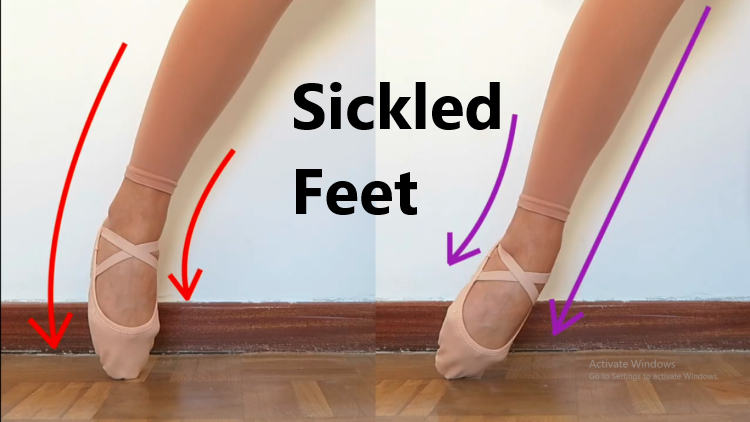Sickled feet refer to a specific foot misalignment in which the toes curve inward and the heel drops back, resembling a sickle. This condition is particularly problematic for dancers, as it can compromise stability, increase the risk of injuries, and disrupt the aesthetic lines required in dance.
Causes of Sickled Feet
Understanding the causes of sickled feet can help prevent and correct this issue. The factors contributing to sickled feet are both intrinsic and extrinsic:
- Intrinsic Factors: These include the natural structure of the foot, such as high arches or flexible ankles, which may predispose some dancers to sickle. The alignment of bones and joints also plays a crucial role.
- Extrinsic Factors: Improper technique, insufficient training, and lack of strength or flexibility in the foot and ankle muscles are significant contributors. Without proper guidance, dancers may develop habits that lead to sickling.
The Impact of Sickled Feet in Dancing
Sickled feet can have several adverse effects on a dancer’s performance and health:
- Ankle Instability: The inward curve of the foot can destabilize the ankle, making it more susceptible to sprains and strains.
- Increased Injury Risk: This position stretches the tendons on the outer ankle, leading to conditions like tendonitis.
- Performance Issues: Poor foot alignment affects balance, posture, and the execution of movements, diminishing overall performance quality.
Preventing and Correcting Sickled Feet
Addressing sickled feet early is crucial for a dancer’s long-term health and performance. Here are some strategies:
- Strengthening Exercises: Focus on exercises that target the ankle and lower leg muscles to enhance stability and support proper alignment.
- Flexibility Training: Regular stretching can improve the range of motion in the ankle joint, helping maintain a straight line from the hip to the toes.
- Improving Technique: Proper training and technique correction are essential. Visual aids like mirrors and working with experienced instructors can help dancers recognize and correct sickling.
Practical Tips for Dancers
Dancers can practice the following exercises to help prevent and correct sickled feet:
- Proprioception Drills: Sit with your legs extended, flex, and point your toes while keeping your eyes closed to increase body awareness.
- Strength Training: Incorporate exercises like ankle circles and theraband resistance workouts to build ankle and foot strength.
- Flexibility Work: Regularly stretch the calf muscles and Achilles tendon to ensure proper ankle mobility.
Conclusion
Sickled feet are a common issue in the dance community, but with the right approach, they can be corrected. Understanding the causes, recognizing the signs, and implementing preventive measures are vital to maintaining healthy feet and ensuring optimal performance. By focusing on proper technique, strengthening, and flexibility, dancers can avoid the pitfalls of sickled feet and continue to perform at their best.
FAQs About Sickled Feet in Dancing
What does sickled feet mean?
Sickled feet refer to a misalignment where the foot curves inward, causing the toes to point toward the body’s midline and the heel to drop back. This position is particularly undesirable in dance due to its impact on stability, technique, and the increased risk of injuries.
What causes sickled feet in dancers?
Both intrinsic and extrinsic factors can cause sickled feet:
- Intrinsic Factors: Natural foot structure, such as high arches or flexible ankles, and the alignment of bones and joints.
- Extrinsic Factors: Improper technique, inadequate training, and a lack of strength or flexibility in the foot and ankle muscles.
How do sickled feet affect dancers?
Sickled feet can lead to several problems for dancers:
- Ankle Instability: Increased risk of sprains and strains due to destabilized ankles.
- Injury Risk: Tendonitis and other injuries due to stretching tendons on the outer ankle.
- Performance Issues: Poor foot alignment affects balance, posture, and the ability to execute movements properly.
Can sickle feet be corrected?
Yes, sickled feet can be corrected through:
- Strengthening Exercises: Targeting the ankle and lower leg muscles.
- Flexibility Training: Regular stretching to improve ankle joint range of motion.
- Technique Improvement: Using visual aids and working with experienced instructors to correct foot alignment.
How can dancers prevent sickle feet?
Prevention strategies include:
- Proprioception Drills: Exercises that improve body awareness and foot alignment.
- Strength Training: Incorporating exercises like ankle circles and theraband resistance workouts.
- Flexibility Work: Regularly stretching the calf muscles and Achilles tendon.
Are sickle feet genetic?
Sickled feet are not genetic, but natural foot structure and alignment can be inherited, predisposing individuals to sickle. Proper training and technique can help mitigate this predisposition.
Why is proper foot alignment important in dance?
Proper foot alignment is crucial for:
- Stability: Ensures balance and prevents falls.
- Technique: Allows for precise execution of movements.
- Injury Prevention: Reduces the risk of sprains, strains, and tendonitis.
What exercises help correct sickle feet?
Exercises that can help correct sickled feet include:
- Proprioception Drills: Sitting with legs extended, flexing, and pointing toes with eyes closed to increase awareness.
- Strength Training: Ankle circles, theraband resistance workouts, and calf raises.
- Flexibility Work: Stretching the calf muscles and Achilles tendon.
How can I tell if I have sickle feet?
You can identify sickled feet by sitting with your legs extended, pointing your toes, and observing if your foot curves inward, disrupting the straight line from your leg to your toes. If the line is not straight, you may be sickling your feet.
When should I seek professional help for sickle feet?
If home training and exercises do not correct the problem, or if you experience pain and instability, it is advisable to seek professional help from a physical therapist or podiatrist experienced in treating dancers.

